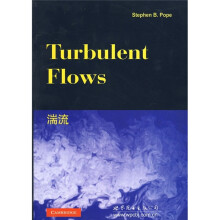湍流

List of tables
Preface
Nomenclature
PART ONE: FUNDAMENTALS
1 Introduction
1.1 The nature of turbulent flows
1.2 The study of turbulent flows
2 The equations of fluid motion
2.1 Continuum fluid properties
2.2 Eulerian and Lagrangian fields
2.3 The continuity equation
2.4 The momentum equation
2.5 The role of pressure
2.6 Conserved passive scalars
2.7 The vorticity equation
2.8 Rates of strain and rotation
2.9 Transformation properties
3 The statistical description of turbulent flows
3.1 The random nature of turbulence
3.2 Characterization of random variables
3.3 Examples of probability distributions
3.4 Joint random variables
3.5 Normal and joint-normal distributions
3.6 Random processes
3.7 Random fields
3.8 Probability and averaging
4 Mean-flow equations
4.1 Reynolds equations
4.2 Reynolds stresses
4.3 The mean scalar equation
4.4 Gradient-diffusion and turbulent-viscosity hypotheses
5 Free shear flows
5.1 The round jet: experimental observations
5.2 The round jet: mean momentum
5.3 The round jet: kinetic energy
5.4 Other self-similar flows
5.5 Further observations
6 The scales of turbulent motion
6.1 The energy cascade and Kolmogorov hypotheses
6.2 Structure functions
6.3 Two-point correlation
6.4 Fourier modes
6.5 Velocity spectra
6.6 The spectral view of the energy cascade
6.7 Limitations, shortcomings, and refinements
7 Wall flows
7.1 Channel flow
7.2 Pipe flow
7.3 Boundary layers
7.4 Turbulent structures
PART TWO: MODELLING AND SIMULATION
8 An introduction to modelling and simulation
8.1 The challenge
8.2 An overview of approaches
8.3 Criteria for appraising models
9 Direct numerical simulation
9.1 Homogeneous turbulence
9.2 Inhomogeneous flows
9.3 Discussion
10 Turbulent-viscosity models
10.1 The turbulent-viscosity hypothesis
10.2 Algebraic models
10.3 Turbulent-kinetic-energy models
10.4 The k-εmodel
10.5 Further turbulent-viscosity models
11 Reynolds-stress and related models
11.1 Introduction
11.2 The pressure-rate-of-strain tensor
11.3 Return-to-isotropy models
11.4 Rapid-distortion theory
11.5 Pressure-rate-of-strain models
11.6 Extension to inhomogeneous flows
11.7 Near-wall treatments
11.8 Elliptic relaxation models
11.9 Algebraic stress and nonlinear viscosity models
11.10 Discussion
12 PDF methods
12.1 The Eulerian PDF of velocity
12.2 The model velocity PDF equation
12.3 Langevin equations
12.4 Turbulent dispersion
12.5 The velocity-frequency joint PDF
12.6 The Lagrangian particle method
12.7 Extensions
12.8 Discussion
13 Large-eddy simulation
13.1 Introduction
13.2 Filtering
13.3 Filtered conservation equations
13.4 The Smagorinsky model
13.5 LES in wavenumber space
13.6 Further residual-stress models
13.7 Discussion
PART THREE: APPENDICES
Appendix .4 Cartesian tensors
A.1 Cartesian coordinates and vectors
A.2 The definition of Cartesian tensors
A.3 Tensor operations
A.4 The vector cross product
A.5 A summary of Cartesian-tensor suffix notation
Appendix B Properties of second-order tensors
Appendix C Dirac delta functions
C.1 The definition of δ(x)
C.2 Properties of rS(x)
C.3 Derivatives of rS(x)
C.4 Taylor series
C.5 The Heaviside function
C.6 Multiple dimensions
Appendix D Fourier transforms
Appendix E Spectral representation of stationary random processes
E.1 Fourier series
E.2 Periodic random processes
E.3 Non-periodic random processes
E.4 Derivatives of the-process
Appenthix F The discrete Fourier transform
Appendix G Power-law spectra
Appendix H Derivation of Eulerian PDF equations
Appendix I Characteristic functions
Appendix J Diffusion processes
Bibliography
Author index
Subject index
Preface
Nomenclature
PART ONE: FUNDAMENTALS
1 Introduction
1.1 The nature of turbulent flows
1.2 The study of turbulent flows
2 The equations of fluid motion
2.1 Continuum fluid properties
2.2 Eulerian and Lagrangian fields
2.3 The continuity equation
2.4 The momentum equation
2.5 The role of pressure
2.6 Conserved passive scalars
2.7 The vorticity equation
2.8 Rates of strain and rotation
2.9 Transformation properties
3 The statistical description of turbulent flows
3.1 The random nature of turbulence
3.2 Characterization of random variables
3.3 Examples of probability distributions
3.4 Joint random variables
3.5 Normal and joint-normal distributions
3.6 Random processes
3.7 Random fields
3.8 Probability and averaging
4 Mean-flow equations
4.1 Reynolds equations
4.2 Reynolds stresses
4.3 The mean scalar equation
4.4 Gradient-diffusion and turbulent-viscosity hypotheses
5 Free shear flows
5.1 The round jet: experimental observations
5.2 The round jet: mean momentum
5.3 The round jet: kinetic energy
5.4 Other self-similar flows
5.5 Further observations
6 The scales of turbulent motion
6.1 The energy cascade and Kolmogorov hypotheses
6.2 Structure functions
6.3 Two-point correlation
6.4 Fourier modes
6.5 Velocity spectra
6.6 The spectral view of the energy cascade
6.7 Limitations, shortcomings, and refinements
7 Wall flows
7.1 Channel flow
7.2 Pipe flow
7.3 Boundary layers
7.4 Turbulent structures
PART TWO: MODELLING AND SIMULATION
8 An introduction to modelling and simulation
8.1 The challenge
8.2 An overview of approaches
8.3 Criteria for appraising models
9 Direct numerical simulation
9.1 Homogeneous turbulence
9.2 Inhomogeneous flows
9.3 Discussion
10 Turbulent-viscosity models
10.1 The turbulent-viscosity hypothesis
10.2 Algebraic models
10.3 Turbulent-kinetic-energy models
10.4 The k-εmodel
10.5 Further turbulent-viscosity models
11 Reynolds-stress and related models
11.1 Introduction
11.2 The pressure-rate-of-strain tensor
11.3 Return-to-isotropy models
11.4 Rapid-distortion theory
11.5 Pressure-rate-of-strain models
11.6 Extension to inhomogeneous flows
11.7 Near-wall treatments
11.8 Elliptic relaxation models
11.9 Algebraic stress and nonlinear viscosity models
11.10 Discussion
12 PDF methods
12.1 The Eulerian PDF of velocity
12.2 The model velocity PDF equation
12.3 Langevin equations
12.4 Turbulent dispersion
12.5 The velocity-frequency joint PDF
12.6 The Lagrangian particle method
12.7 Extensions
12.8 Discussion
13 Large-eddy simulation
13.1 Introduction
13.2 Filtering
13.3 Filtered conservation equations
13.4 The Smagorinsky model
13.5 LES in wavenumber space
13.6 Further residual-stress models
13.7 Discussion
PART THREE: APPENDICES
Appendix .4 Cartesian tensors
A.1 Cartesian coordinates and vectors
A.2 The definition of Cartesian tensors
A.3 Tensor operations
A.4 The vector cross product
A.5 A summary of Cartesian-tensor suffix notation
Appendix B Properties of second-order tensors
Appendix C Dirac delta functions
C.1 The definition of δ(x)
C.2 Properties of rS(x)
C.3 Derivatives of rS(x)
C.4 Taylor series
C.5 The Heaviside function
C.6 Multiple dimensions
Appendix D Fourier transforms
Appendix E Spectral representation of stationary random processes
E.1 Fourier series
E.2 Periodic random processes
E.3 Non-periodic random processes
E.4 Derivatives of the-process
Appenthix F The discrete Fourier transform
Appendix G Power-law spectra
Appendix H Derivation of Eulerian PDF equations
Appendix I Characteristic functions
Appendix J Diffusion processes
Bibliography
Author index
Subject index
《湍流》是一部研究生湍流教程,是以作者在Cornell大学数年的教学讲义为基础,用新颖的观点,全面综合讲述湍流这一流体动力学的重要组成部分。全书的内容分为两个组成部分,并且附有大量的附录,一部分集中介绍湍流的基本知识,其工作原理,以及如何量化,也包括基本物理过程;第二部分介绍了跟湍流模型和模拟有关的各种方法;附录部分增加了理解《湍流》所必需的数学技巧。目次:(一部分)基础:导引;流体运动方程;湍流的统计描述;均值流动方程;自由剪切流;湍流运动尺度;壁流;(第二部分)模型和仿真:模型和仿真引入;直接数值模拟;湍流涡粘度模型;雷诺应力及其相关模型;PDF方法;大涡模拟;(第三部分)附录。
读者对象:适用于工程运用物理专业研究生水平的学生,应用数学专业,物理,海洋学、大气科学等方向的科研人员。
读者对象:适用于工程运用物理专业研究生水平的学生,应用数学专业,物理,海洋学、大气科学等方向的科研人员。
比价列表
1人想要
公众号、微信群
 缺书网
缺书网微信公众号
 扫码进群
扫码进群实时获取购书优惠






